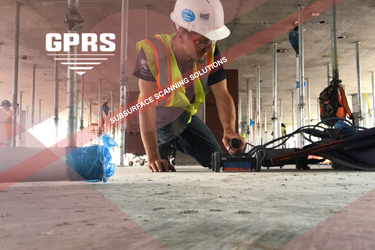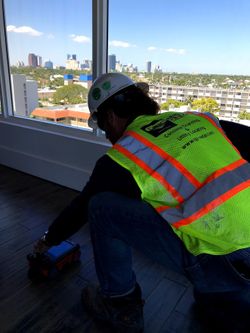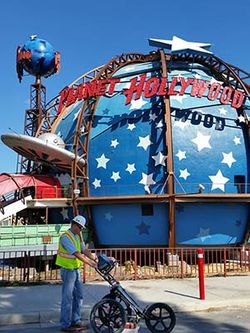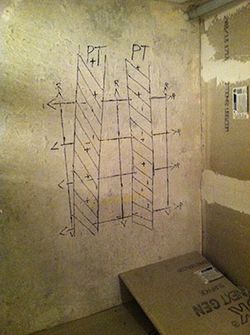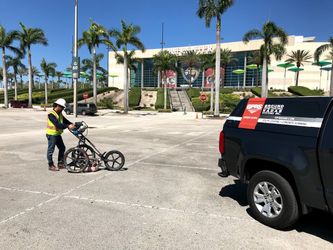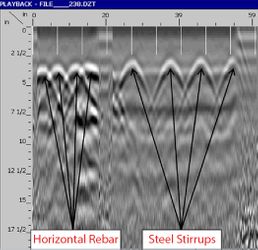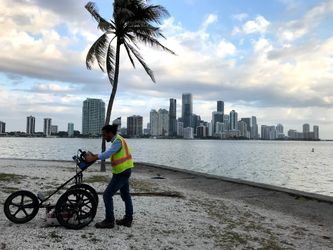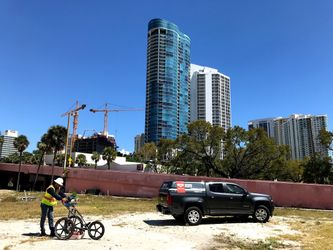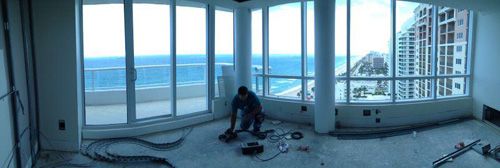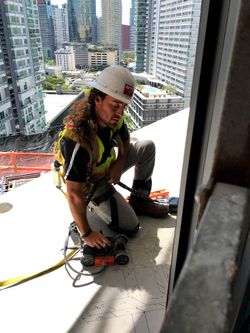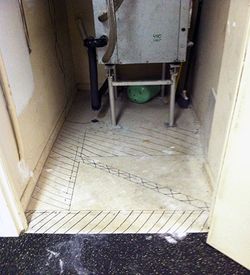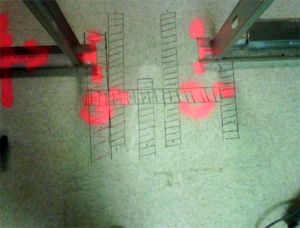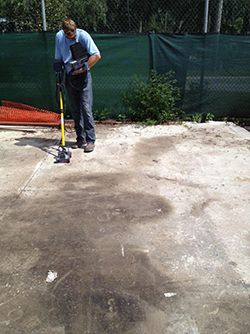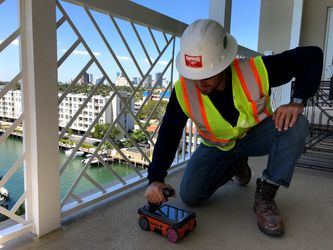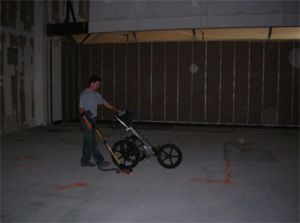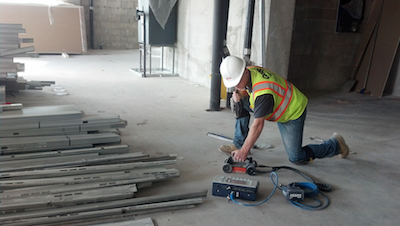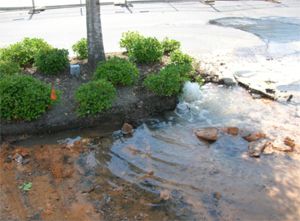Past Project Archive
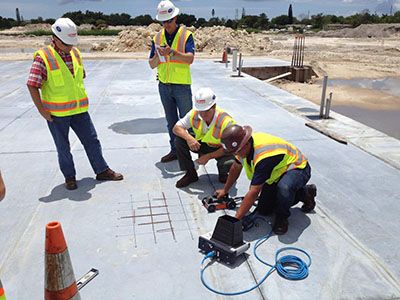
Featured Concrete Scanning Story
GPR Used To Scan Concrete for Compressive Strength Testing
A general contractor asked Ground Penetrating Radar Systems to scan the slab at that load location to locate and mark any reinforcing steel. Central Florida GPRS, LLC. technician, David Abueg, scanned the concrete and provided markings on the surface. This allowed the contractor to see the locations of the welded wire mesh and choose a clear spot for the representative core sample to be cut.
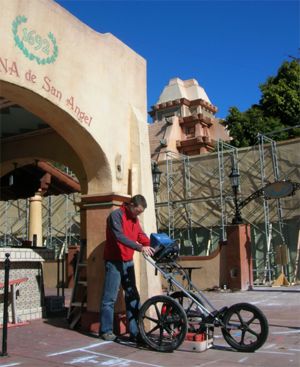
Featured Utility Locating story
GPR Project At Disney's Epcot
Whiting-Tuner was contracted by Walt Disney to demo and construct a new attraction at the Epcot theme park near Walt Disney World in Lake Buena Vista, FL. Whiting Turner wanted to be certain that they did not, in any way, hinder other park operations by hitting or damaging any existing utilities serving other areas of Epcot. Their solution was to hire Ground Penetrating Radar Systems out of Orlando, FL.
In our modern world energy will always be a big commodity. Energy plants will forever have to keep up with our growing society, technology and population. With this growth energy plants must make frequent changes over time to keep up and to keep it clean.
A team from one of the largest energy providers in Orlando was recently in need to make some changes to their plant structure by adding a new building. The plan involved a fair amount of digging in areas where there are a lot of major utilities, including a fire protection line, gas supply, electrical supply and so on. Although they have drawings for this site the construction team was weary of the accuracy of the as-builts and knew there were additional utilities that were not on the drawings. Since they did not have a concrete clear picture of what was underground the team decided to call another team in that has plenty of experience locating underground utilities. They reached out to their contacts at Ground Penetrating Radar Systems, Inc., also known as GPRS. GPRS is known for its ability and expertise in locating and identifying underground utilities and scanning concrete, among other things.
more
Hospitals and the medical industry in general have a lot to keep up with. Our country has one of the largest medical industries in the world and one of the most advanced. With a growing industry, changes must be made to facilities to accommodate for new technology, bigger wings and more business.
The staff at one of the largest hospitals in Orlando recently decided to take added measures and expand one of the wings of their hospitals. Part of the plan involved deconstructing a wall that is topped with a sidewalk and contains known utilities running inside of it. Although they have drawings for this site, the construction team wanted to make sure they were not going to hit any underground utilities when deconstructing the wall. Fortunately, the construction team had worked with a company that specializes in locating utilities. They reached out to Ground Penetrating Radar Systems, Inc., also known as GPRS. GPRS is known for its ability and expertise in locating and identifying underground utilities and , scanning concrete, among other things.
The wall GPRS scanned is a relatively unique utility locate as the client wanted to scan not only for utilities but also for items contained in the concrete structure itself. Fortunately, GPRS is used to handling projects like this. The plan was to locate utilities from the top of the sidewalk and then scan the concrete along the side of the wall for conduits or other anomalies present such as post-tension cables or rebar. This ensured that all utilities that were able to be located, were located. To locate the utilities, the GPRS team member uses a variety of equipment. They use a combination of an EM pipe locator and two different GSSI manufactured radar antennas, designed to locate subsurface items. The area in question was scanned and all findings were marked on the concrete with either markers or spray paint. After marking out the utilities, the GPRS team member was to send a job summary report to the client summarizing the findings. Each time a location is marked out the GPRS team member will send site photos and the job summary report after the job is completed.
moreGround Penetrating Radar Systems of Florida was recently contracted to complete a site investigation prior to major renovation and construction at a local Miami mall. The mall was going to be staying open through all phases of the project and delays due to utility damages or other line-strike issues were a major cause of concern for both the Mall Owners and the General Contractors on site.
GPRS of Florida was tasked with not only locating and painting all the utilities including post-tension cables, conduits, rebar, and voids found on site, but also documenting the location of each utility with as much accuracy as possible. The technologies used on this project included the standard locating equipment (400 MHz antenna and EM locator), but also included a Geode (GPS collection device) and a Drone to create an orthomosaic map of the areas scanned.
moreAt GPRS, our motto is “Subsurface Scanning Solutions”. We believe in working with customers to solve problems. There are limitations to what our equipment can accomplish because the science of GPR itself has limitations. We get calls every week for jobs that are beyond the margins of what’s possible, but we strive to innovate solutions for our customers. This month alone, we came up with a number of solutions. Here are a few examples:
- In Orlando, a customer brought us out to scan a new slab, freshly poured, and the concrete had not cured long enough for the GPR to see all the way through the slab. We could have walked away, saying, “Sorry, but our equipment cannot see deep enough.” but this customer had to drill. They needed a solution. So we grabbed a lower frequency antenna (sees deeper), requested the PT plans, found the column lines and verified each piece of PT in order to show that there was no PT in the customer’s drill location.
- In Jacksonville, a customer called us because they needed to verify the presence of rebar in a concrete pier. The problem is that the relevant section of the pier was 20 feet underground. Within 24 hours, we offered them three potential solutions, and two referrals.
Inspecting the internal condition of gravity utility pipes is not a new thing in the world of underground utilities. However, it is something that has become increasingly important as many gravity utility infrastructures have become older, and the pipes have been compromised over the years. A problem with a sewer or storm drain pipe can cause major concerns, such as: sink holes, ground water contamination, soil contamination, sewage overflows, and many more.
moreThere is a lot happening in Tampa right now, and we have recently expanded our North Florida team to stay ahead of the demand. We believe that scheduling GPR should be simple. You should trust the team you call. You should know that they have your best interest in mind. Scheduling an appointment should be quick, and you shouldn’t have to wait a week to receive service. Every technician should arrive on time and be friendly, qualified, and dedicated to your project. He should make clear markings, explain what they mean, and his results should be industry leading in their accuracy. We believe that our Tampa customers deserve our above and beyond, standard. Everything we do is a reflection of these beliefs.
We recently got a call from a new customer in the Tampa area and we were able to mobilize a technician the next day. Nate used a high frequency GPR antenna to scan for anomalies in and directly below the slab, and then he used a low frequency antenna to scan for utilities deeper down. Finally, he swept the scan are with our EM technology to detect conduit and live wires.
In slab on grade situations, GPRS can typically scan about 50 linear feet of trenching per hour, and on this occasion Nate Schmoe performed the work and exceeded that level of production. He completed the customer’s requested scope in the allotted time, and located multiple pieces of shallow conduit that likely would have been hit without the scan.
moreGround Penetrating Radar Systems was recently contacted to locate sub-surface utilities at a local attraction in Central Florida. The scope of the project was to saw cut the road way and side walk to install a new sanitary line for a new development. It was important for GPR to be performed on this project in order to locate the sub-surface utilities below the roadway and sidewalk prior to saw cutting.
After meeting and walking the site with the contractor for just a few minutes, GPRS technicians had a good idea of where to get started and began scanning. We covered the areas requested and marked all utilities located directly on the surface with colored marking paint. We color coded the lines so the saw cutters could identify what the lines were. On each line located, we also included the depths of the utilities.
moreA plumbing contractor needed to core drill in a post tension slab in West Palm Beach, Florida. The concrete area that needed to be scanned / x-rayed, using ground penetrating radar, was a pre-existing concrete slab and was known to be a post tensioned slab. Thus they contacted the concrete specialists in post tension cable locating, Matt Rankin of GPRS. This application, post tension cable locating, is a common job for GPR. GPRS, LLC. in South Florida took the call and mobilized to the site.
On site, GPRS was able to identify the post tensioned cables, quickly and accurately. After scanning the concrete, we marked the post tension cables and rebar on the surface. GPRS then collaborated with the contractor, as to the depth and location of the post tensioned cables. The advantage to radar compared to X-Ray is that radar can locate the post-tension cables from the surface of the ground, without dangerous radiation. The project was a success and why radar is “The New Way to X-Ray”.
Matt Rankin runs GPRS operations in the South Florida area. This includes Vero Beach to Miami. He can be reached at (561) 252-6132 or matt.rankin@gprsinc.com. Locating post tension cables is a very frequent service performed by the GPR technicians at GPRS, LLC.
morePost tension cables, electrical conduits, rebar and other structural steel, water pipes and various other objects are often found in concrete slabs. Construction companies, plumbing contractors, electrical contractors and renovation specialists are always in need of either core drilling through a slab or trenching through a slab on grade. Whatever the case may be Ground Penetrating Radar Systems has an expert level of understanding when it comes to the need to “x-ray” or radar before you go penetrating a concrete slab.
In Melbourne, FL there are constantly needs arising when it comes to this. A local plumbing contractor was tasked with relocating some existing plumbing lines. Having used GPRS a time or two before they felt confident the professionals there would be able to give them the attention needed to get through the slab without cutting anything critical and that they could locate the plumbing lines to be moved.
GPRS showed up on site and used the 1600Mhz and 400Mhz antennas to scan the floor. The professional on site scanned the entire area in a grid pattern to assure that there was no mistaking the location of the plumbing. Contractors only like to cut through a slab once if they can avoid it. After mapping out the areas the GPRS professional used markers to indicate where the plumbing was located. These findings were then relayed to the site contact to ensure all information was accurately communicated. The client was able to penetrate, cut and trench in the areas scanned without hitting or cutting any electrical conduits or critical structural steel. The client expressed gratitude on the quick turn around time and skill the technician brought to the project. Clients who use GPRS know they are getting the highest level of service when using our product.
moreA General contractor needed to locate the number of structural rebar in concrete columns for an inspection in Miami, Florida. The area that needed to be concrete scanned / x-rayed, using ground penetrating radar, was located in a condominium in Miami, Florida and needed the rebar in the concrete column located. Thus they contacted the specialist in concrete inspection. This application, concrete inspection, is a common job for GPR. GPRS, LLC. in South Florida took the call and mobilized to the site.
On site, GPRS was able to identify the location of the rebar, quickly and accurately. They provided a report explaining the results. GPRS then collaborated with the general contractor, as to the depth and location of the rebar. The advantage to radar compared to X-Ray is that radar can locate rebar, post-tension cables and electrical conduits without dangerous radiation. The project was a success and why radar is “The New Way to X-Ray”.
Chris Moore runs GPRS operations in the South Florida area. This includes Ft. Lauderdale, Miami and the Florida Keys. He can be reached at (321) 331-2127 or by email at chris.moore@gprsinc.com. Concrete inspections for rebar, post-tension cables and electrical conduits are a very frequent service performed by the GPR technicians at GPRS, LLC.
moreA contractor needed to locate some water lines at the South Florida Underwater Operations Base in Key West. The area that needed to be scanned, using ground penetrating radar, was located on a special section of Key West, Florida for The United States Army. Thus, they contacted specialists in Utility Locating, GPRS. This is an ideal application for ground penetrating radar as underground utility locating is a GPR specialty. GPRS, LLC. in South Florida took the call and mobilized to the site.
On site, GPRS was able to identify the underground water lines quickly and accurately. They marked them on the surface of the ground and provided a report explaining the results. GPRS then collaborated with the contractor as to the approximate depth and location of the underground water lines. The advantage to ground penetrating radar compared to X-Ray is that radar can locate underground and does not need access to the underside of whatever is needed to be located. The project was a success and is why radar is “The New Way to X-Ray”.
It is an honor for us to work for our Army Special Forces. GPRS, LLC. has family in the Armed Forces and understand and appreciate the anonymity and security of working in such a secure area. When our men and women of the Armed Services call on us to perform simple yet critical services for them, it is an absolute privilege.
moreGround Penetrating Radar Systems was recently contacted to locate a potential underground septic system at an office building near Daytona Beach. Prior to environmental drilling, it was necessary to locate the septic system and associated lines.
The equipment used in the scan was a three-wheeled cart carrying a 400 MHz antenna capable of identifying objects at a depth of 8-10 feet, and a SIR-3000 computer system.
While on site, GPRS technicians scanned approximately ½ acre to locate common utilities and any strange anomalies surrounding the site. A major benefit of the 3 wheeled cart set up (pictured below) is the surface coverage. We are able to scan large areas in a timely fashion as well as scanning over many types of surfaces. After further investigation at the suspected site we were able to determine that there was not an underground septic tank. The customer had previously walked the site and mistook a pipe protruding from the ground as a ventilation pipe for a septic system. The pipe turned out to be an old mount for a street sign. The nearby sanitary cleanouts and all other utilities located were marked on the surface with marking paint. If the customer decides to proceed to do environmental testing and drilling on site, they will now know where all utilities are located in this area to avoid a strike.
moreA contractor needed to locate the structural steel rebar inside the concrete columns of a home. The area that needed to be surveyed, using ground penetrating radar, was located on Ramrod Key near Key West, Florida. Thus they contacted specialists in Structural steel locating, GPRS. This is an ideal application for ground penetrating radar as rebar locating are GPR specialties. GPRS, LLC. in South Florida took the call and mobilized to the site.
On site, GPRS was able to identify the rebar in the concrete quickly and accurately. They marked them on the surface of the columns and provided a report explaining the results. GPRS then collaborated with the contractor, as to the depth and location of the rebar. The advantage to radar compared to X-Ray is that radar can locate the rebar at any side of the column and without dangerous radiation. The project was a success and why radar is “The New Way to X-Ray”.
Chris Moore runs GPRS operations in the South Florida area. He can be reached at (321) 331-2127 or by email at chris.moore@gprsinc.com. Concrete scanning for the purposes of identifying the location of rebar, post-tension cables, beams and electrical conduits is a very frequent service performed by the GPR technicians at GPRS, LLC.
moreGround Penetrating Radar Systems, LLC. (GPRS) was contacted by a contractor in order to locate any anomalies such as electrical lines, water lines & septic lines at a recycling center in Sarasota, Florida. The contractor needed to make certain of where anomalies were in order to clear areas where they planned to conduct soil borings. The company contacted GPRS of Tampa, Florida in order to know where the lines were located in order to avoid them when drilling into the earth.
Justin Rasanow of GPRS was contacted in order to perform the survey at this location. Using our 400MHz antenna radar equipment and RD-7000, we were able to map out all of the anomalies on the surface which were running through the areas of concern as well as provide depths to the tops of the anomalies found. The contractor was pleased with our results and felt relieved that they could conduct their borings with peace of mind.
To the right is a photo taken on-site which depicts Justin Rasanow scanning the area of concern using our 400MHz antenna.
moreA General contractor needed to core drill holes in the concrete to install new plumbing pipes in a condominium in Ft. Lauderdale, Florida. The area that needed to be concrete scanned / x-rayed, using ground penetrating radar, was located on Ft. Lauderdale Beach Blvd. and was known to be a post tensioned slab. Thus they contacted the specialists in post tension cable locating, Ron Anderson of GPRS. This application, post tension cable locating, is a common job for GPR. GPRS, LLC. in South Florida took the call and mobilized to the site.
On site, GPRS was able to identify the post tensioned cables, quickly and accurately. They marked them on the surface of the ground and provided a report explaining the results. GPRS then collaborated with the general contractor, as to the depth and location of the post tensioned cables. The advantage to radar compared to X-Ray is that radar can locate the post-tension cables from the surface of the ground, without dangerous radiation. The project was a success and why radar is “The New Way to X-Ray”.
Chris Moore runs GPRS operations in the South Florida area. This includes Martin County, Palm Beach, Ft. Lauderdale, Miami and the Florida Keys. He can be reached at (321) 331-2127 or by email at chris.moore@gprsinc.com. Locating post tension cables for the installation of plumbing pipes is a very frequent service performed by the GPR technicians at GPRS, LLC.
moreA General contractor needed to core drill holes in the concrete to dowel new rebar to reinforce new concrete walls in a government building in Miami. The area that needed to be concrete scanned / x-rayed, using ground penetrating radar, was a new construction project and was known to be a post tensioned slab. Thus they contacted the specialists in post tension cable locating, Ron Anderson of GPRS. This application, post tension cable locating, is a common job for GPR. GPRS, LLC. in South Florida took the call and mobilized to the site.
On site, GPRS was able to identify the post tensioned cables, quickly and accurately. They marked them on the surface of the ground and provided a report explaining the results. GPRS then collaborated with the general contractor, as to the depth and location of the post tensioned cables. The advantage to radar compared to X-Ray is that radar can locate the post-tension cables from the surface of the ground, without dangerous radiation. The project was a success and why radar is “The New Way to X-Ray”.
Chris located the post tension cables in the concrete, Chris Moore runs GPRS operations in the South Florida area. This includes Ft. Lauderdale, Miami and the Florida Keys. He can be reached at (321) 331-2127 or by email at chris.moore@gprsinc.com. Locating post tension cables for drilling holes is a very frequent service performed by the GPR technicians at GPRS, LLC.
moreIcon Identity Solutions had a project at the Southwest Florida International Airport in Ft. Myers, Florida which involved them anchoring two signs into the floor of a concrete parking garage. They decided to contact Ground Penetrating Radar Systems to ensure that they would be able to safely drive the anchors without striking any utilities or steel structural support that may be in the concrete. Icon had used GPRS’s services in the past and knew that they could provide the desired results quickly, accurately, and safely.
GPRS quickly informed them that with their technology it should not be difficult to locate areas for them to safely anchor their signs. GPRS mobilized to the site and was able to complete the survey in about an hour and a half. Within that time they used ground penetrating radar and radio detection to precisely locate all rebar in the concrete and verify that no utilities were present in either of the areas.
In this photo you can see Adam double checking his final markings of utilities beneath the concrete with his 1600 MHz antenna. If you are interested in obtaining more information or a quote please visit out “Contact us” page for a local representative near you.
moreFlorida Industrial Electric performs multiple projects every year at the Orlando International Airport. The projects range from installing simple floor outlets to complex DAS upgrades to the 4 different airsides at OIA. Florida Industrial Electric continues to use Ground Penetrating Radar Systems for their entire elevated concrete slab locating services. GPRS consistently provides information on what reinforcing steel and electrical conduits may be in the concrete to ensure that FIE protects the structural integrity of the airport and avoids costly shut-downs that can occur from hitting a conduit.
moreGPRS was recently contacted by a contractor to locate known and unknown structural steel (including post tension and rebar) on a rooftop of a condominium complex in Destin, Florida. The contractor planned to install anchor plates and bolts to support new cell phone antennas. All anomalies that could be located were marked on the surface with their direction leaving a map on the surface to aid with anchor bolt placement. This allowed the contractor to save time and money from costly repairs of any potentially damaged post-tension cables that would have been encountered otherwise.
If you would like more information about ground penetrating radar or to request a quote, please visit our website at www.gp-radar.com or contact Josh Gross at (318) 376-5014 or josh.gross@gprsinc.com.
moreWhen Sharp General Contractors of Pompano Beach, Florida needed to saw cut two trenches into an existing concrete slab on grade without hitting any electrical conduits or utilities they contacted GPRS, LLC. of Orlando, Florida. Two new electrical conduits needed to be run to the base of a new piece of medical equipment called an ExacTrac at a local hospital in Lauderdale Lakes, FL. Sharp General Contractors was contracted to perform the installation of the ExacTrac and this included the saw cutting. They decided to contact Ground Penetrating Radar Systems to make sure they did not strike/hit any utilities that might be in contact with the bottom of the concrete. This is a great application for GPR because the technology not only allows us to pin point the exact location of potential conduits and utilities but also provides an approximate depth to the top of the pipe located. Radar provides the approximate depth which in turn lets the concrete cutting company know where they need to raise or lower their saw blades to avoid costly and dangerous utility strikes. Also, being that this location was an active doctors office ground penetrating radar was the proper technology because there are no harmful effects emitted from the radar unit.
moreIn September, Ground Penetrating Radar Systems, LLC. (GPRS) was contacted by a construction company in order to locate utilities at a power plant in Crystal River, FL. The construction company needed utilities located, marked out on the surface with paint, flags, and a depth. After marking out all utilities, the contractor needed all findings put into a cad map file for the company to have on file. The contractor contacted GPRS of Tampa to perform the GPR and GPS mapping needed for this project. The contractor needed this project completed in order to be able to expand their operations area.
Isaiah Runkle of GPRS was contacted in order to perform the survey at this location. Using our 400MHz antenna and RD7000 radar equipment, we scanned each area of concern. We were able to map out all needed buried utilities. All located utilities were marked with paint, flags and a depth to the top of the anomaly directly on the surface. After all areas of concern were located and marked out, I clearly relayed the findings to the onsite contact. The contractor was pleased with our results and felt relieved to know where the utilities were located, and at what depth each utility was prior to excavating.
moreA General contractor needed to core drill holes in the concrete to install new fire sprinkler risers in a condominium in Palm Beach. The area that needed to be concrete scanned / x-rayed, using ground penetrating radar, was a remodeling construction project and was known to be a post tensioned slab. Then they contacted Matt Rankin of GPRS to do the concrete scanning, to indeed find out it was a post tension slab. This application, post tension cable locating, is a common job for GPR. GPRS, LLC. in South Florida took the call and mobilized to the site.
On site, GPRS scanned the concrete and was able to identify the post tensioned cables and electrical conduits quickly and accurately. They marked them on the surface of the ground and provided a report explaining the results. GPRS then collaborated with the general contractor, as to the depth and location of the post tensioned cables and conduits. The advantage to radar compared to X-Ray is that radar can locate the post-tension cables from the surface of the ground, without dangerous radiation. The project was a success and why radar is “The New Way to X-Ray”.
Chris Moore runs GPRS operations in the South Florida area. This includes Ft. Pierce to Ft. Lauderdale. He can be reached at (321) 331-2127 or by email at chris.moore@gprsinc.com. Concrete scanning to locate post tension cables for the installation of plumbing pipes is a very frequent service performed by the GPR technicians at GPRS, LLC.
moreA general contractor, constructing new municipal County buildings, received a concrete test report with low compressive strength results at one location in a concrete slab.
In order to conduct further testing, the lab sampling specifications require a core sample at the concrete load location that did not meet plan requirements. Per the specifications, the core sample cannot contain any rebar or welded wire mesh that may cause inaccurate compressive strength results.
The contractor asked Ground Penetrating Radar Systems to scan the slab at that load location to locate and mark any reinforcing steel. Central Florida GPRS, LLC. technician, David Abueg, scanned the concrete and provided markings on the surface. This allowed the contractor to see the locations of the welded wire mesh and choose a clear spot for the representative core sample to be cut.
For more information on how GPRS, LLC. can provide solutions to your concrete scanning needs, please visit the “Contact us” page at www.gp-radar.com to contact your local GPRS representative.
moreA contractor was planning to make sever penetrations on a post tension slab at an office building in Miami, Florida. The contractor was planning to install new plumbing drains and had to make 4-5 penetrations through the elevated post tension reinforced concrete slab. The area they needed to have survey was roughly 3’x3’ in size. They contact Ground Penetrating Radar Systems knowing that this was the exact type of work they specialize in.
Once on site GPRS used their 1500MHz antenna, specifically designed to provide high resolution concrete images of the precise location of the rebar, post tension cables and electrical conduit. Ground penetrating radar is an effective and efficient tool for accomplishing these goals and GPRS has the area mapped on the surface of the concrete in less than 30 minutes. Once the marking was complete the ground penetrating radar technician took time to explain the results so they contract would know exactly where to drill. This ensured that the building did not face and structural damage and, more importantly, that the contractor was safe during the drilling process. All parties were pleased with the results and the holes were drilled without incident.
moreGPRS was called out to a location recently to assist in a crime scene investigation. GPRS technicians have been successful in locating burial sites and perform many cemetery locates. In this case, it was suspected that human remains may have been buried in the site that was under survey. It was up to GPRS to use GPR to locate the remains and help solve a missing person case.
The equipment used in the scan was a three-wheeled cart carrying a 400 MHz antenna capable of identifying objects at a depth of 8 feet, and a SIR-3000 computer system. Also used was a 1600 MHz antenna that is effective to depths of approximately 24” and is ideal for scanning concrete. After scanning with the 400MHz antenna, we had a few areas of concern that we wanted to check with the 1600MHz antenna. Soil disturbances were detected with 400MHz antenna just below the slab. Using the 1600MHz we were able to increase the resolution and determine a number of target areas to saw cut and dig for the missing person remains.
moreGround Penetrating Radar Systems was dispatched to a local hotel in Jacksonville, Florida to scan a 10 inch slab filled with rebar, post-tension cables and conduit prior to core drilling. The contractor was remodeling and installing a new kitchen and needed to install floor drains, floor sinks and many utilities that all required separate core drilling locations in the slab. GPRS scanned approximately 40 locations and marked out all of the obstructions prior to drilling. The technicians used a 1600 MHz ground penetrating radar antenna (safer and quicker that X-ray) to locate the obstructions. The GPR scan helped the contractor to avoid injuring any of their workers by having the post tension and live conduit marked out. In the image below you can see GPRS technician Adam Yunker scanning with the 1600 MHz antenna. If you would like similar work performed, please visit the “Contact us” page.
GPRS does not provide geophysical, geological, land surveying or engineering services. If you need such services, please contact an appropriate professional.
moreSunTrust Bank had a vacant property where they were going to perform an environmental investigation and determined that they needed to survey the area with ground penetrating radar. The purpose of the GPR survey was to determine the presence and location of any underground storage tanks and buried utilities that might still be on site. Suntrust planned to perform several soil borings and other similar tests to determine the environmental impact the site currently has. In order to perform the GPR survey they contacted Ground Penetrating Radar Systems, LLC. of Orlando, FL. This is a very common application for ground penetrating radar and Chris Moore with GPRS was certain their system would be able to perform the requested services. GPRS has used ground penetrating radar to perform this type of survey on multiple occasions.
Once on site GPRS surveyed roughly 2 acres in one day mapping utilities and searching for UST’s. GPRS did not find any evidence of an underground storage tank but they found several utilities that SunTrust will avoid when they return to this site to perform their soil borings. All of the utilities found were painted on the surface and at one point the site contact excavated a small hole to check the accuracy of the GPR equipment. The equipment proved to be accurate to within 2” of the correct depth of the utility discovered. With this type of accuracy achieved on-site the SunTrust Representative was extremely pleased with the results of the survey. They were highly complementary and we at GPRS look forward to working with them again in the future.
moreWhen Industrial Commercial Structures of Orlando, Florida needed to saw cut and excavate roughly 3,000 square feet of concrete without hitting any of the existing utilities buried beneath a 6” concrete slab at the Melbourne Mall they contacted GPRS, LLC of Orlando, Florida. ICS was just getting started with a tenant build out at the mall. The build out required that a large section of the existing concrete be saw cut and removed so new plumbing and electrical lines could be installed. There was concern on the part of ICS and the Melbourne Mall that unknown utilities would be cut or damaged during the saw cutting and removal process. Ground Penetrating Radar Systems places a high priority on customer service and accuracy in results and was willing to do what it took to get the work done for ICS.
moreWhen Preferred Builders of Naples, Florida needed to determine the concrete thickness and reinforcing steel presence in a concrete slab poured over metal pan decking they contacted GPRS, LLC of Orlando, Florida. Preferred Builders was planning a project in which they were renovating some office space at the Regions Bank building in Naples, FL. Prior to cutting the concrete they wanted to make sure they knew exactly what they would hit. Preferred Builders originally searched and found Ground Penetrating Radar Systems, LLC. on the internet at www.gp-radar.com. Once on the website they learned of GPR’s ability to provide non-destructive testing of concrete and contacted Ground Penetrating Radar System’s local office in Orlando, FL. It was explained to Preferred Builders that ground penetrating radar would be able to determine the location of the reinforcing steel in the concrete and also determine the concrete thickness. Because the slab was on top of metal decking it made the project more difficult, yet GPRS was able to instill confidence that they could get the job done.
On site GPRS surveyed two areas of concrete to determine the reinforcing steel presence and the concrete thickness. The reinforcing steel was mapped on the surface and, as expected, was a 6”x6” wire mesh. The concrete thickness was also tested and was able to show Preferred Builders that the concrete was only 2-2½” thick. These pieces of information were critical to project moving forward. After all of the testing was completed GPRS processed the data and generated a job specific report for Preferred Builders. Overall the project was a success and Preferred Builders was satisfied with the information and data ground penetrating radar was able to provide on their project.
moreGround Penetrating Radar Systems was recently contacted to locate reinforcing steel in slab on grade at a popular Resort & Spa in central Florida. The rebar in the concrete slab of the pool floor was suspected to be too close to the surface of the slab, therefor causing rust stains on the pool floor surface when the rebar got wet. Facilities management called on GPRS, LLC. to help locate thea steel to determine if it was the cause of the surface staining.
After draining the pool down just a couple of feet, GPRS technicians were able to locate the existence and location of rebar within the slab and mark them out directly on the dry surface of the concrete with blue tape. The concrete at this location was found to be approximately 9-10” thick with rebar throughout on 12” centers at approximately 5-7” deep. The GPR equipment provided by GSSI is designed to scan on most surfaces provided that they are dry to mark on and are fairly flat. The ability to identify where the steel was placed in this slab was very beneficial for the crew as they now had the information to determine what might be causing the surface staining.
The equipment used in the scan was a four-wheeled, handheld cart carrying a 1600 MHz antenna capable of identifying objects at a depth of approximately 24” deep. The antenna relays its signal to an SIR-3000 computer system which displays the geophysical data.
moreWhiting-Tuner was contracted by Walt Disney to demo and construct a new attraction at the Epcot theme park near Walt Disney World in Lake Buena Vista, FL. The first phase of the project was to demo the existing “Cantina” structure to make way for the new building. This may seem like a simple, clear cut process, however, Disney’s park design and utility layout can make it complicated. Whiting Turner wanted to be certain that they did not, in any way, hinder other park operations by hitting or damaging any existing utilities serving other areas of Epcot. They needed a way to ensure that they located as many active and in-active utilities as possible without disrupting the soil or soft digging. Their solution was to hire Ground Penetrating Radar Systems out of Orlando, FL.
Once on site, Chris Moore (GPRS Technician) used ground penetrating radar to non-destructively locate many of the utilities running in and around the “Cantina”. Chris used a 400MHz GPR antenna to determine the location of the utilities and mark them on the surface. Approximate depth indications were also provided for each utility found.
moreThe pictures you see to the right are from a local attraction in Orlando, FL. The demolition contractor was removing a curb when they unknowingly broke a main feed line for the sprinkler system. This would normally not have been something difficult to remedy. However, they did not know where the shut-off valve was for the system. With this problem hundreds of gallons of water were wasted and the ground will have to be repaired prior to work continuing.
more

![4screen-15.08.39[24.10.2019].png](https://static.spacecrafted.com/a3aaadbc07d54ecc87529796790d84c4/i/f375cfd70e1a46739bbb6e87cb0ac1c6/1/4SoifmQpDrHbZJ6Vvf4aQ/4screen-15.08.39%5B24.10.2019%5D.png)

